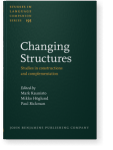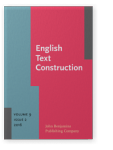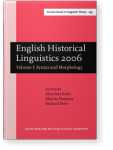Thomas Egan
List of John Benjamins publications for which Thomas Egan plays a role.
Journal
Titles
Time in Languages, Languages in Time
Edited by Anna Čermáková, Thomas Egan, Hilde Hasselgård and Sylvi Rørvik
[Studies in Corpus Linguistics, 101] 2021. vi, 307 pp.
Subjects Comparative linguistics | Corpus linguistics | Historical linguistics | Theoretical linguistics
Cross-linguistic Correspondences: From lexis to genre
Edited by Thomas Egan and Hildegunn Dirdal
[Studies in Language Companion Series, 191] 2017. vii, 298 pp.
Subjects Corpus linguistics | Theoretical linguistics
2024 Simple and complex help constructions in English and Norwegian: A contrastive study Comparing Crosslinguistic Complexity, Ström Herold, Jenny and Magnus Levin (eds.), pp. 84–108 | Article
This paper reports on a study of verbal help constructions in English and Norwegian. It is based on data from the English–Norwegian Parallel Corpus, and discusses 11 constructions in all, nine of which have a close parallel in the other language. The constructions vary in syntactic complexity… read more
2023 Giving in English and Norwegian: A contrastive perspective Ditransitives in Germanic Languages: Synchronic and diachronic aspects, Zehentner, Eva, Melanie Röthlisberger and Timothy Colleman (eds.), pp. 365–403 | Chapter
This chapter investigates ditransitive constructions and their prepositional dative alternates, containing the cognate verbs English give and Norwegian gi, using data from the English–Norwegian Parallel Corpus (Johansson 2007). The bi-directional nature of the corpus enables us not only to… read more
2021 Just a moment: Brief times in English and Norwegian Time in Languages, Languages in Time, Čermáková, Anna, Thomas Egan, Hilde Hasselgård and Sylvi Rørvik (eds.), pp. 155–180 | Chapter
This chapter investigates two temporal lexemes, English moment and Norwegian øyeblikk, which may encode either a point in time (‘x happened at time y’) or an interval of time (‘x lasted for time y’). The data for the study comprise all instances of the two lexemes in the English and Norwegian… read more
2021 Time in languages, languages in time Time in Languages, Languages in Time, Čermáková, Anna, Thomas Egan, Hilde Hasselgård and Sylvi Rørvik (eds.), pp. 1–8 | Chapter
2018 Passive permissives: Being let and allowed Changing Structures: Studies in constructions and complementation, Kaunisto, Mark, Mikko Höglund and Paul Rickman (eds.), pp. 31–54 | Chapter
The ‘let NP bare infinitive’ construction differs from other common permissive constructions, such as ‘allow NP to-infinitive’ and ‘permit NP to-infinitive’ in being exceedingly rare in the passive. That is, while somebody may well be ‘allowed to do’ something, they are very seldom ‘let do’… read more
2017 Chapter 5. locative at seen through its Swedish and Norwegian equivalents Cross-linguistic Correspondences: From lexis to genre, Egan, Thomas and Hildegunn Dirdal (eds.), pp. 121–146 | Chapter
At is commonly understood to be one of three basic topological prepositions in English, the other two being in and on. While there are close equivalents in Swedish and Norwegian to both in and on, this is not the case for at. This chapter investigates the choices made by both Swedish and Norwegian… read more
2017 Chapter 1. Lexis in contrast today Cross-linguistic Correspondences: From lexis to genre, Egan, Thomas and Hildegunn Dirdal (eds.), pp. 1–34 | Chapter
2013 Tertia comparationis in multilingual corpora Advances in Corpus-based Contrastive Linguistics: Studies in honour of Stig Johansson, Aijmer, Karin and Bengt Altenberg (eds.), pp. 7–24 | Article
This paper compares coding of the concept of ‘betweenness’ in English and French on the basis of translations of expressions in the same Norwegian texts into both languages. It argues that the original Norwegian expressions comprise a viable tertium comparationis for the comparison of the other two… read more
2013 Moving over in(to) English and French: A translation-based study of ‘overness’ Text-based contrastive linguistics, Altenberg, Bengt and Karin Aijmer (eds.), pp. 193–211 | Article
In this paper we discuss ways in which the concept that, for want of a better word, we may describe as ‘overness’ is coded in motion predications in English and French. The concept of ‘overness’ is a relational one, the basic spatial sense of which involves some sort of (elongated) superiority of a… read more
2013 Distinguishing causative and permissive readings of the Swedish verb låta Functions of Language 20:1, pp. 64–89 | Article
In this paper an account is given of the semantics of the Present-day Swedish verb låta ‘let’ in constructions with an infinitival complement. It is generally assumed that the verb låta in this construction type can encode either causation or permission. From a synchronic perspective, the… read more
2012 Prefer: The odd verb out English Historical Linguistics 2010: Selected Papers from the Sixteenth International Conference on English Historical Linguistics (ICEHL 16), Pécs, 23-27 August 2010, Hegedűs, Irén and Alexandra Fodor (eds.), pp. 215–228 | Article
This paper traces the historical development of the verb prefer, with a particular emphasis on its occurrence with non-finite complements. Special attention is paid to the spread of the ‘prefer to’ construction in the 19th century at the expense of ‘prefer -ing’, a development running counter to… read more
2011 Perception and conception: The ‘see x to be y’ construction from a cognitive perspective Converging Evidence: Methodological and theoretical issues for linguistic research, Schönefeld, Doris (ed.), pp. 57–80 | Article
This chapter revisits a construction discussed by Bolinger (1974), investigating whether his intuitive interpretation of it holds in the light of robust corpus data. Bolinger’s interpretation has been disputed, notably by Noël (2003), on the basis of what he takes to be diverging evidence from the… read more
2010 The ‘fail to’ construction in Late Modern and Present-Day English English Historical Linguistics 2008: Selected papers from the fifteenth International Conference on English Historical Linguistics (ICEHL 15), Munich, 24-30 August 2008., Lenker, Ursula, Judith Huber and Robert Mailhammer (eds.), pp. 123–142 | Chapter
This paper traces the development of the ‘fail to’ construction over the last three hundred years. In the eighteenth century, almost 95 percent of tokens of ‘fail to’ were negated. In corpora from the late twentieth century, on the other hand, fewer than 4 percent of all tokens of ‘fail to’ are… read more
2008 Emotion verbs with to-infinitive complements: From specific to general predication English Historical Linguistics 2006: Selected papers from the fourteenth International Conference on English Historical Linguistics (ICEHL 14), Bergamo, 21–25 August 2006, Gotti, Maurizio, Marina Dossena and Richard Dury (eds.), pp. 223–240 | Article
This paper traces the evolution of to-infinitive complement constructions with the emotion matrix verbs like, love, hate and prefer over the past two hundred years. It proposes that when the matrix verb is not preceded by a modal auxiliary these constructions should be analysed in Present-day… read more














